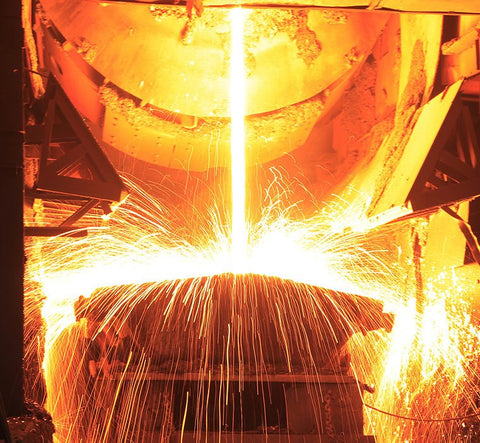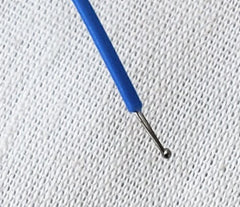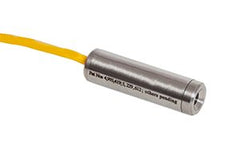Part of the Industrial Temperature Measurement and Control Blog

Monitoring and controlling temperature is an integral part of most industrial processes. Temperature measurement starts with the sensor and although temperature sensors may be simple devices, choosing the right sensor for an application can be critical to reliable and repeatable measurement. In this article, the first part of our series on Industrial Temperature Measurement and Control we will look at the most common temperature sensors, their basic operation, and their application strengths and weaknesses. To be covered are thermocouples, resistance temperature detectors(RTDs), infrared sensors(IR), thermistors and integrated circuit(IC) sensors. In subsequent articles we will look that these sensors and their use in much greater details.
Thermocouples
Theory of Operation
A thermocouple consists of two wires of dissimilar metals joined at one end. Temperature is a sensed at the point where the wires are joined. This point is referred to as the junction, the joint, the bead or the hot end (even though the measurement temperature may be colder than ambient temperature). There are several different variations of thermocouple styles depending on your application and needs. The common styles are beaded wire thermocouples, surface thermocouples, thermocouple probes and head and well assembly's. You can learn more about styles and thermocouple characteristics in our thermocouples 101 article.
When the thermocouple is subject to a temperature gradient across its length it produces a small voltage caused by the Seebeck Effect. The voltage produced is a very low-level non-linear signal which can be correlated the temperature. The metal from which the thermocouple is made determines its measurement characteristics such as accuracy and temperature range. Some thermocouples are constructed from very common metals like iron or copper while others are constructed from more rare and exotic metals like platinum or rhodium. Thermocouples made from the exotic metals are used for measurement of extremely high temperature ranges beyond 1,200°C.
Application Strengths and Weaknesses
Because thermocouples are simply constructed from two wires joined at a point, they can be formed into various shapes and sizes which are optimized for different applications. For instance, thermocouples made of very fine wire have very low thermal mass making them well suited for applications requiring a fast response time. Or the joint of the thermocouple can be formed flat making it ideally suited for surface measurement. Thermocouples vary in price depending on their material of construction, but the thermocouples used in most applications are low cost compared to other temperature sensors. Thermocouples support broader temperature ranges than any other temperature sensor with the ability to measure both very low and very high temperatures. There is also a huge variety of instruments available on the market which are compatible with thermocouples.
One of the main disadvantages of the thermocouple is its output is small and non-linear which requires signal conditioning circuitry to read and convert the signal to a temperature. The low-level signal may also be easily impacted by electrical noise in the environment especially if proper noise reduction practices are not followed. Thermocouples are also one of the least accurate temperature sensors with accuracy ranging from 1°C to several degrees C depending on the type of thermocouple.

|
|
This photo of a thermocouple illustrates the beaded junction. Model TC-GT-K-36 from IOThrifty |
Check out IOThrifty's lineup of Thermocouples.
Infrared Temperature Sensors
Infrared (IR) Temperature sensors have the unique distinction of being the only non-contact temperature sensor.
How They Work
All objects with a temperature above 0°K emit infrared energy. Infrared energy is how the sun transfers heat to the Earth. An infrared sensor has an internal element which absorbs the infrared energy and produces an output based on that energy which can be used to determine the objects temperature. The sensor does not need to contact the object it only needs to be pointed at the object with a direct line of site to determine the objects temperature. Infrared sensors vary in complexity from simple low-cost infrared thermocouples which produce a thermocouple signal output to more complex and expensive thermal imagers which can produce a graphic image showing a temperature profile of a target.
Application Strengths and Weaknesses
Extremely versatile sensors they are very well suited for surface measurement and are the best and possibly only solution when contact with a sensor is not possible. Some feature very high response rates and can measure extremely high temperature ranges. They are however limited to measuring surface temperature of a solid or the surface of a liquid. They cannot be used for gases or liquid immersion temperature measurement. There accuracy is typically ranges from 1-2°C.
 |
|
This infrared thermocouple measures temperature via infrared and produces a thermocouple output. Model IR-EX-IRT/C-K from IOThrifty |
Check out IOThrifty's lineup of Infrared Temperature Sensors.
RTDs
RTDs very commonly used temperature sensors. Although thermocouples are still very popular in the United States, RTDs have a dominance in most other parts of the world.
Theory of Operation
RTDs are resistance based temperature sensors. The traditional RTD consists of a thin wire wound around a ceramic or glass core. As the temperature of the wire changes its resistance also changes. The change in resistance is precise and repeatable and can be correlated back to temperature. The wire used in the RTD can be made from different metals, but most are made from platinum with a resistance at ambient temperature of 100 ohms, thus the term PT100 is synonymous with RTD. There is also a style of that are manufactured through semi-conductor manufacturing process in which the platinum is deposited onto a substrate in a pattern designed to create the desired base resistance. These RTDs referred to as thin film RTDs tend to be very economical but must be manufactured in high volumes.
Application Strengths and Weakness
The temperature range of an RTD is -200 to 600°C, which is less broad than thermocouples and infrared sensors but still acceptable for most industrial processes. RTDS can provide accuracy of 0.5°C or better depending on the temperature. Because their output is resistance they perform well in industrial environments where ambient electrical noise is present. Wire wound RTDs are not well suited for surface measurement applications or applications where a fast response is needed because of the size and form factor. However, thin film elements are smaller and can be made into shapes which both increase response time and make them better suited for surface measurement. Because of the platinum content of the wire, RTDs tend to be more expensive than thermocouples.
Thermistors
Highest accuracy temperature sensor but with a narrower temperature range than most other sensors.
How They Work
Thermistors like RTDs are resistance-based sensors which change resistance with varying temperature. They are constructed of a sintered metal oxide ceramic mix and generally have a very high base resistance of several thousand ohms. Thermistors used for temperature measurement normally have a negative temperature coefficient (NTC) which means their resistance increases as the temperature decreases. Although thermistors are available with operating temperatures up to 600°C they are much more commonly available with upper an upper range of 100°C
Application Strengths and Weaknesses
With accuracies as high as ±0.1°C the thermistor is a great good choice as long at the operating temperature range of the thermistor is within the application temperature range. Since applications requiring that level of precision typically have a lower temperature range, the limited range of the thermistor may not be a weakness. The major weakness of thermistors in industrial temperature measurement is the lack of compatibility with instrumentation. There are many different types of thermistors and the they do not follow a standardized temperature/resistance curve which means pairing them with other instruments such as signal conditioners, controllers or indicators is a challenge. They may even require custom signal conditioning circuitry to interpret the temperature in a meaningful way.
Integrated Circuits (IC) Temperature Sensors
IC temperature sensors are the least often used sensor for industrial temperature measurement, but we have include them because there are applications where there use may be warranted.
How They Work
As the name implies they are semi-conductor based integrated circuits designed to provide an output that is usually linear to the temperature input. A typical output is 10 mV/°K which means at 25°C(298°K) the output would be roughly 300mV. IC temperature sensors are also available with a digital output which provides easy integration into digital instrumentation.
Application Strengths and Weaknesses
Because the output is either a linear or digital signal they require very limited signal conditioning. This can bring down the overall system cost and provide easy interface to other instrumentation. The biggest weakness is the limited temperature range which is normally –55° to 150°C. The accuracy is better than a thermocouple but not as good as a thermistor.
Industrial Temperature Sensor Comparison Chart
|
|
Thermocouple |
Infrared |
Thermistor |
RTD |
IC Sensor |
|
Temperature Range |
High |
High |
Low |
Medium |
Low |
|
Accuracy |
Low |
Low |
High |
Medium |
Medium |
|
Response Time |
High |
High |
Medium |
Medium |
Medium |
|
Cost |
Low |
Medium-High |
Medium |
Medium |
Low |
|
Surface Measurement |
Good |
Best |
Limited |
Limited |
Limited |
|
Gas Measurement |
Yes |
No |
Yes |
Yes |
Yes |
|
Liquid Immersion |
Requires Probe |
No |
Requires Probe |
Requires Probe |
Requires Probe |
|
Compatibility with other Instruments |
High |
High |
Low |
Medium |
High |

